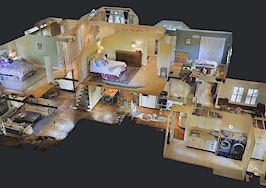- Real Estate Webmasters seizing growing need for enhanced visuals in property marketing.
Have suggestions for products that you’d like to see reviewed by our real estate technology expert? Email Craig Rowe.
Real Estate Webmasters (REW) helps real estate agents make an impression on the internet and then translate that impression into clicks, leads and clients.
It’s now releasing a new feature that will seize the growing need for enhanced visuals in property marketing, allowing agents to capture high-resolution 360-degree video for individual listing websites. At the same time REW looking into how its customers can combine virtual reality business with its offerings.

“Vision” is the name of the 360-degree multimedia upgrade; the visual format is one you’ll see on Facebook quite often. However, it’s the method and efficiency by which Vision deploys such imagery that offers a notable advantage to other tools.
Agents can use a couple of different cameras to capture content, but the Samsung Gear 360 or Ricoh Theta offer the best balance of quality and affordability.
Finished imagery can be uploaded in a couple of clicks via Vision’s standalone backend user interface.

It wouldn’t be difficult for an agent to build a new listing page with this type of content a few minutes before sitting down to pitch services. (An iPad would prove to be compelling presentation tool in such a scenario.)
Images can be served up as the background of the property’s website to create a memorable first impression.

I couldn’t help but move my phone around to view the expansive exterior of a sample listing. It looked great on my iPhone 7s, as did the mobile-first website on which the listing rested.
Properties showcasing the immersive photos are labeled with an “enhanced” tag.
On the VR front, the company recommends that users combine branded Google Cardboard headsets with Vision to set themselves apart.

While not cumbersome to create, virtual tours do take time, and they don’t look awesome when the home isn’t suitably staged. Understand that rolling out a VR-based marketing effort takes some commitment. You’ll also have to be careful with pitching it.
Not every listing is worth the effort, but you may have clients who think their property is more than worthy. Tread lightly.
I suggest nailing down your content creation process and having a few samples ready to run before showing it off to prospective customers. Ask your best sellers to be a part of your pilot program.
Virtual reality tours would be very effective for those firms with retail storefronts that rely on walk-in browsing as a lead source.
My town, Truckee, has an Engel & Volkers, Sotheby’s International Realty and a Chase within a half-mile of each other in Old Town, our busy tourist district.
Listing flyers cover the weathered wood-encased windows of the Sotheby’s while the Chase office calls home the first floor of a refurbished Victorian. Engel & Volkers agents sit at spartan metal desks in a ’60s-era gas station garage bay.
(In March, E&V announced a partnership with immoviewer, a 3-D tour platform.)
The contrast of renovated historical office space and cutting-edge virtual property tours would be too obvious to ignore.
I would think the first among them to show a VR listing to an interested buyer has the best chance of getting them to closing day.
Editor’s note: Real Estate Webmasters reached out to clarify that it has no formal relationship with Google Cardboard nor is it offering branded Google Cardboard headsets; the company is currently investigating such a partnership for customers that use Vision. The story has been updated accordingly.
Have a technology product you would like to discuss? Email Craig Rowe.













